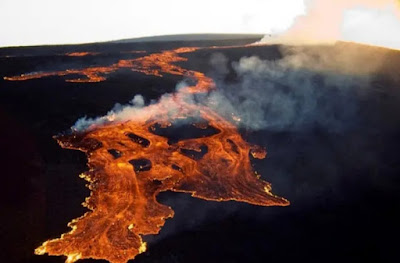The U.S. Geological Survey and other authorities reported that Mauna Loa, the biggest active volcano in the world, has started to erupt in Hawaii, leading officials to advise residents of Hawaii's Big Island to prepare for the worst.
According to a USGS Hawaiian Volcano Observatory alert, the eruption began late on Sunday at around 11:30 p.m. HST in Moku'weoweo, the summit caldera of Mauna Loa in Hawaii Volcanoes National Park. The observatory claimed to be closely collaborating with partners in emergency management.
Early on Monday, the eruption was contained to the summit caldera, but USGS Volcanoes and the Hawaii Emergency Management Agency subsequently reported that some of it had overflowed into the southwest side. USGS Volcanoes reported the eruption had moved to the northeast rift zone and that lava flows were moving downslope to the north shortly before 12:20 p.m. EST (7:20 a.m. HST).
The eruption in the northeast rift zone is still ongoing, according to a later update from USGS Volcanoes, but no lava is erupting from the southwest rift zone.
"Outside the Northeast Rift Zone, no eruptive activity is anticipated. No property is currently in danger "Twitter user USGS Volcanoes posted.
It might take weeks or even months for the lava to reach Hilo, Hawaii, or other places in East Hawaii in the event of a northeastern eruption. Communities could be impacted by lava that emerges from a southwest rift zone within hours or days.
According to the USGS Hawaiian Volcano Observatory, the lava flows are not yet posing a threat to any downhill neighbouring settlements. Even so, Pele's Hair, which are tiny strands of volcanic glass, and volcanic gas could "be carried downwind."
The northeastern rift zone appears to be where the eruption will persist, according to the Observatory.
The Hawaii Emergency Management Agency tweeted in response to the development, "The move of the erupting region towards the northeast rift zone takes the hazard into considerably less steep terrain."
"While the lava is still very hot and liquid, eruptions on steep terrain quickly descend. It flows more slowly downhill on shallow slopes because it can cool off more. In contrast to eruptions on steeper slopes, those in the NE rift zone may take weeks or months to reach the sea."
Shelters have been opened as a precaution in Kailua-Kona and Pahala, despite the fact that the adjacent municipalities are not now in danger.
Bobby Camara, a Volcano Village resident who has lived on the Big Island his entire life, advised island residents to follow the eruption. He emphasised the need for awareness and claimed to have witnessed three Mauna Loa eruptions in his lifetime.
Everyone, he continued, "should be a little bit concerned." We don't know where the flow is going or how long it will last, either.
Since lava flows can "alter swiftly," the USGS advised residents who may be in danger from Mauna Loa lava flows to review their eruption preparations. A map of the Mauna Loa Lava Inundation Zones is available for reference from the Hawaii County Civil Defense.
"Lava flows will probably be contained within the caldera walls if the eruption continues in Moku'weoweo. However, lava flows could proceed quickly downslope if the eruptive vents relocate outside of its walls "In its Sunday night advisory, the USGS Hawaiian Volcano Observatory made this statement.
An ashfall warning also applied to parts of the Big Island on Monday morning, but it was lifted later in the day. Even after the advisory was lifted, officials advised people with respiratory illnesses or sensitivities to take precautions.
As a result of the eruption on Monday afternoon, the Hawaii Department of Health cautioned locals and visitors to be ready for potential changes in the quality of the air. According to the department of health, the air quality was still acceptable as of 7 p.m. EST.
The department issued a warning nonetheless, saying that "the eruption could cause vog conditions, ash in the air, and levels of sulphur dioxide to increase and fluctuate in various areas of the state."
The department advised people to take precautions, such as limiting outdoor exposure and wearing masks when outside to prevent breathing in hazardous particulates, as conditions can change quickly.
Scientists have been on high alert for an eruption because there has been a rise in earthquakes at the summit of Mauna Loa. After the eruption on Sunday night, Mauna Loa's volcano alert level was upgraded from advisory to warning, and its aviation alert was changed from yellow to red.
Mauna Loa rises 13,679 feet above sea level and last erupted in 1984. It is one of the Big Island of Hawaii's five volcanoes.
According to the USGS Hawaiian Volcano Observatory, Mauna Loa is located just north of Kilauea volcano, which is also erupting but with a "watch" volcano alert level and an orange aviation alert. 700 homes were destroyed and lava was poured into the ocean by a Kilauea eruption in 2018.
Experts point out that because Mauna Loa is taller than Kilauea, it may rush down some of its hillsides more quickly due to their steeper slopes, possibly in a matter of hours.



0 Comments